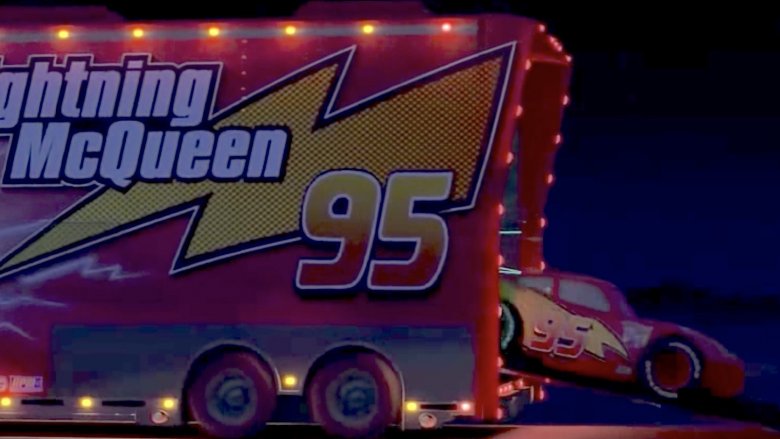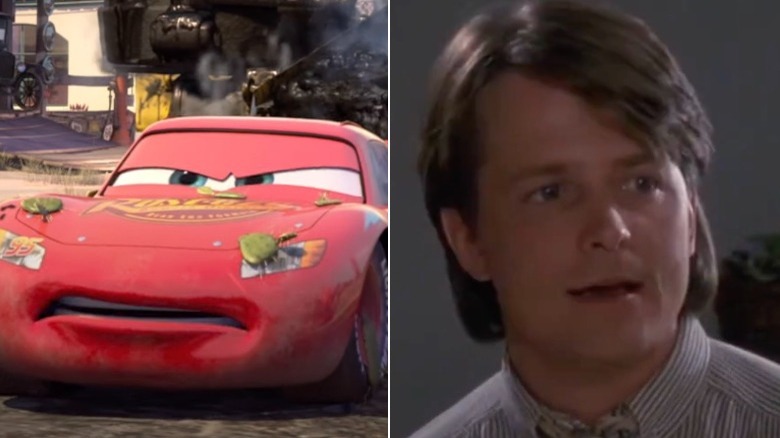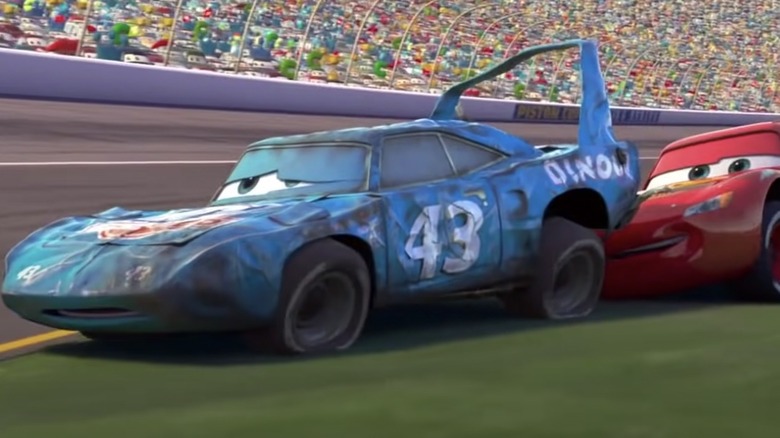Things About Cars You Only Notice As An Adult
Yet another entry in a long line of critically-acclaimed blockbusters for Pixar Animation Studios, "Cars" tells the story of a cocky race car named Lightning McQueen who learns there's more to life than racing. Like a lot of Pixar pictures, it also presents a richly detailed world — this one fully populated by cars, completely revolving around cars ... while also giving audiences relatable, humanity-laden characters and a poignant plot.
"Cars" came out nearly two decades ago, so a lot of the kids who were mesmerized by the movie in 2006 are now old enough to notice its many other layers — including jokes, references and, quite frankly, some very weird and disturbing things about the "Cars" universe.
There's a lot of adult humor
There aren't any outright dirty jokes hidden in "Cars," but there are a lot of suggestive ones that sail right over the heads of its five-year-old fans.
For example, Lightning McQueen is a famous race car, and he's got the groupies to prove it. After his big race at the beginning of the movie, two red cars named Mia and Tia proclaim to be his "biggest fans" and then literally flash him ... their headlights. Later, in the movie's central location of the sleepy town of Radiator Springs, Lightning meets Sally, who has a "tribal" style "pin-striping tattoo" just above her bumper — the "Cars" equivalent of a "tramp stamp" lower-back tattoo.
In another scene, Lightning barges in on Doc Hudson in his garage — or rather doctor's office, where he's got Sheriff elevated to examine his undercarriage. Sheriff asks Lightning if he got "a good look." When Lightning tells Mater that he discovered Doc Hudson was once a three-time winner of the illustrious racing championship the Piston Cup, Mater incredulously exclaims, "He did what in his cup?" (Say "Piston Cup" out loud if you don't get it)
Character names, and who voices them, were cleverly chosen
The names of characters — and the actors filmmakers hired to play those characters — offer many references that only parents in the know, old movie fans and car enthusiasts would be hip to.
For example, the late comedian and countercultural icon George Carlin gave voice to Fillmore, a hippie Volkswagen bus — the kind of car countless real hippies drove (and "Fillmore" bears a similarity to the Fillmore West, a theater in San Francisco where '60s bands like Jefferson Airplane and the Grateful Dead often played). Champion race car "The King" is voiced by Richard Petty, the NASCAR legend known as "The King."
Even Ray Magliozzi and his late brother Tom (a.k.a. Click and Clack), longtime hosts of 1977-2012 National Public Radio mainstay "Car Talk," have cameos as the owners of Rust-eze, the "bumper ointment" company that sponsors Lightning McQueen. Radiator Springs' diner equivalent, Flo's V8 Cafe, is operated by a former show car named Flo. Her job on-screen primarily consists of server-like duties, paralleling that of Florence Jean Castleberry, or just Flo, the sassy waitress (played by Polly Holliday) known for shouting "kiss my grits!" to diner boss Mel on the popular '70s sitcom "Alice."
The races are glorified track and field events
As it is in the human world, car racing is a hugely popular sport in "Cars." But the cars aren't driving automobiles, like humans do in the real world. Instead, they're essentially around a track, using their actual bodies.
That means auto racing in "Cars" is essentially a super-fast, super-competitive track and field event. It's also very high-stakes and highly competitive — cars bump each other and jockey for position at high speeds, leaving each other in the dust or slammed against the wall. This would be like if Carl Lewis or Usain Bolt knocked each other out of the way as they ran. Maybe that violent edge is why the "Cars" version of "running" is so much more of a popular spectator sport than the real world's running sports.
The races are brutally violent
Spinouts, collisions, and accidents happen relatively frequently in real-world auto racing events. But the cars are so packed with protective equipment that drivers rarely get hurt. The vehicles take a lot of damage, but fans don't think too much about it because those cars don't feel pain.
But they do in "Cars." Think about it: Even the most minor racing incident is, more or less, a horrific injury.
Getting a piece of the car's body knocked off? That's like if a human runner lost a body part, mid-race. A blown tire? The equivalent of a shattered foot. Viewed this way, the aggressive racing style of the villainous Chick Hicks — which causes the King to roll over multiple times — equates to gladiatorial combat with intent to harm or kill.
The Pizza Planet truck as you've never seen it before
Pixar is known for lacing its films with well-hidden jokes and Easter eggs, and "Cars" is no exception.
Ever since its first appearance in "Toy Story," the beat-up yellow Pizza Planet delivery truck has made an appearance in most every Pixar movie. So, it makes perfect sense that it would show up in "Cars," a movie populated entirely with motorized vehicles. The P.P. truck appears for just a quick flash as part of a crowd scene before one of Lightning McQueen's big races — and only in "Cars" could the Pizza Planet delivery truck be a living creature with eyeballs and a mouth.
But when you think about it, the implication of a pizza delivery truck in "Cars" means there must be pizza in this universe. So, are some cars shoving a Meat Lovers' special into their gas tank?
The Mack/Lightning McQueen arrangement is a little odd
In creating the "Cars" world, everything about the human world had to be translated into its car equivalent. Usually, it works: "Cow tipping" has been replaced with "tractor tipping," and Flo's V8 Café serves gas and oil rather than food, for example. However, not everything is a direct corollary, making for some very strange moments.
One example of this is how Lightning McQueen travels from race to race. As is the case with a real-world race car, he's hauled around in the back of a specially-built truck. In "Cars," that truck is presented as something between a private jet and a limousine, stocked with amenities to ensure maximum comfort for Lightning. But because this is the world of sentient cars, the truck is a living thing.
This means Mack drives down the freeway with Lightning McQueen literally inside of him. This is akin to a private jet pilot who keeps rich clients in his stomach.
Does it take place in an alternate universe ... or somewhere else entirely?
Kids can watch "Cars" on a surface level: Cars do stuff, cars learn lessons, cars race. Older people, however, may be left wondering: How and why is the world of "Cars" this way?
It's about a place virtually identical to 21st century Earth, only everything is built for cars rather than humans. But they also enjoy human culture that seems based on our real-world things, celebrities and pop culture moments. Radiator Springs is situated on the disused Route 66. Fillmore is mentioned to have lived through the '60s. Comedian and talk show host "Jay Limo" makes an appearance. They even speak English — well, except for Guido, who speaks Italian.
So what's going on here, exactly? Does "Cars" take place in an alternate dimension where automobiles are the dominant species and humans don't exist? Or is this some sort of post-apocalyptic, post-human Earth where cars have evolved to a place of sentience and adopted the cultural touchstones of the now-extinct human race? Either option feels like it could just as easily be the plot of a horror movie, rather than a film for children.
There is probably sex in the world of Cars
While it's unclear how the cars of "Cars" come into existence, there's a strong argument it's done biologically — as in a mommy car and a daddy car get together ... and a few months later, a brand new car is born.
The "Cars" world is designed to be identical to the human world, after all — so, rather than getting your date into the backseat of a '67 Chevy, perhaps a successful date night culminates in getting a '67 Chevy into the backseat of a larger '67 Chevy?
Take Lightning McQueen and Sally, who flirt a bunch and are clearly into each other. Or Mater and Holley Shiftwell, who become an item in "Cars 2." Ramone and Flo of Radiator Springs are married as well, which all strongly suggests that some of these cars are bumping bumpers on the regular.
But it's all a biological imperative that probably leads to little baby cars. Birds do it, bees do it ... even educated Chevys do it.
There are a lot of adult products on offer in Cars
Younger viewers in Pixar's target audience for the film may not even be able to read yet, but they probably still wouldn't understand the adult nature of the fictional products being pitched in "Cars." For example, Mack and Lightning McQueen drive past "Top Down Truckstop," an establishment which proudly boasts its "convertible waitresses." In the land of "Cars," it means that the servers can take their tops down — i.e., they're topless.
Lightning McQueen's primary race sponsor is Rust-eze, a "bumper ointment." It's a topical cream for a car's rear-end, or the automotive equivalent of Preparation H, a product humans use to treat hemorrhoids. On a similar note is the company that sponsors Lightning McQueen's fellow racer, Claude Scruggs. He gets his funding from Leak Less Adult Dripping Pans — the "Cars" version of adult diapers. Then there's Tow Cap, a Piston Cup sponsor. They make a device that covers a car's trailer hitch — which would serve a similar purpose as a condom (for cars).
A major supplier of gasoline to the cars of "Cars" is Dinoco. As gas is food to automobiles, this would make it the equivalent of a human food conglomerate, on the level of Kraft or Archer Daniels Midland. Adult viewers may also recognize it as a link to other Pixar movies — the Pizza Planet truck in "Toy Story" stops in to refuel at a Dinoco station.
Some characters are named after what kind of car they are
While some of the car characters in "Cars" perfectly embody their name, others are known by names that reflect their make, model, or function — designations that would be clear only to adults, or viewers with at least a passing knowledge of automobile history.
For instance, in his career as a race car, Lightning McQueen gets around from race to race in the back of a big Mack truck — a friendly, helpful behemoth whose name is literally Mack. Prickly Radiator Springs physician Doc Hudson is named after (and has the appearance of) a Hudson Hornet, a super-fast car of 1950s vintage, while local hotel operator Sally Carrera gets her name from the Carrera model of Porsche, of which she is an example. Radiator Springs town founder Stanley is named for the Stanley Steamer, an early, steam-powered car, while his surviving spouse, Lizzie, gets her name from the nickname for the Ford Model T — also known as a "Tin Lizzie."
Meanwhile, cars of all kinds are bothered by insects, or more specifically "bugs," presented as tiny Volkswagen Beetles, colloquially known as "Bugs."
The real reason why Paul Newman's character doesn't like Lightning McQueen
Radiator Springs's old town doctor Doc Hudson is voiced by late Hollywood legend Paul Newman, who also raced professionally.
Older viewers of "Cars" may remember that Newman played a speedy driver on screen in the 1969 movie "Winning," which hit theaters a year after "Bullitt," an action-packed police movie that featured one of the most legendary car chase scenes ever shot. That film starred Steve McQueen, who famously did much of his own stunt work, and had earned a reputation in films like "The Great Escape" as a fearless driver.
McQueen was a hotshot on the asphalt (on-screen and off), not unlike Lightning McQueen, with whom the actor shares a name. So, in the first "Cars" movie, Doc Hudson is initially dismissive and openly hostile toward Lightning — with the animosity alluding to a real-life conflict between McQueen and Newman.
At the peak of their success in the 1960s and 1970s, Paul Newman and Steve McQueen were seen as Hollywood rivals, often competing for the same roles. McQueen was nearly cast in "Butch Cassidy and the Sundance Kid," but turned the role down when he learned Newman would get top billing. McQueen later made a passion project out of the 1971 film "Le Mans," where he played a driver who delivered the famed line: "Racing is life. Everything that happens before or after is just waiting." Paul Newman took things one step further in 1979, when he raced a Porsche 935 in the real Le Mans, finishing first in his class (and second overall) in a rain-soaked race.
Dick Barbour, who co-drove with Newman and coached McQueen, once said that although both actors were good at racing, the source of their skills couldn't be more different. "Paul was a very methodical driver. He wasn't a natural like Steve," Barbour said. "McQueen picked it up immediately."
In 1974, the duo were paired together onscreen for the first and only time, in the blockbuster film "The Towering Inferno." Ever the competitors, when McQueen got his script for the Irwin Allen disaster flick, he counted out his lines to see if he had more than Newman.
Cars is a remake of Doc Hollywood
While on the surface it's a kids' movie about talking cars, Pixar's "Cars" is a poignant tale of redemption, of one individual realizing what's important in life. This is a story of choices, regrets, and one laced with melancholy, which has way more appeal to adults than it does to kids. It also might feel familiar, because older viewers may already have consumed this story in a very similar form.
In 1991, Michael J. Fox starred in the live-action comedy movie "Doc Hollywood." A moderate box office hit that lived on for years thanks to home video and cable TV re-airings, it has almost the exact same plot as "Cars," released 15 years later.
Fox played cocky young plastic surgeon Dr. Ben Stone, driving across the country in his red sports car until he crashes it in Grady, South Carolina, and as a sentence for the property damage he causes, he's forced to work in the local hospital for a while. He decides to stay in Grady after falling in love with charming ambulance driver Lou (Julie Warner).
In "Cars," cocky young car Lightning McQueen is riding across the country on his way to a race until he crashes in Radiator Springs, and as a sentence for the property damage he causes, he's forced to repair the road. He decides to stay in Radiator Springs after falling for charming motel proprietor Sally.
There are a lot of Richard Petty references
The most idolized race car in "Cars" is easily The King. His name is, after all, The King, and that nickname (and his number, 43) comes straight from Richard "The King" Petty, the all-time winningest racer in NASCAR history who voices his Pixar counterpart. Older viewers, and especially racing aficionados, may notice a couple of famous on-the-track events from Petty's illustrious career adapted into the action of "Cars."
In the film's climactic race, The King suffers a horrific spin-out and crash, mirroring one the real Petty (driving his "Superbird," the basis for The King of "Cars") endured in the 1988 Daytona 500. In a show of remarkable sportsmanship — and that he's evolved into a kind and selfless guy — Lightning McQueen cuts short his now assured win to push The King across the finish line. A similar event went down at Daytona in 1976, although it was Petty's pit crew that helped him finish the race, not another racer.













